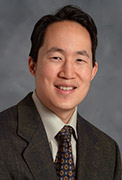CV: Dr. Stanley Liu
A scientist in molecular and cellular biology and the Odette Cancer Research Program at Sunnybrook Research Institute sits down to answer a few questions from Jim Oldfield.
Bio basics: Since January 2011, a scientist in molecular and cellular biology at Sunnybrook Research Institute (SRI) and radiation oncologist in the Odette Cancer Program at Sunnybrook. Assistant professor of radiation oncology at the University of Toronto. Completed a PhD in medical biophysics in 2000, an MD in 2004 and a radiation oncology residency in 2009, all at U of T. Finished postdoctoral research at the Gray Institute for Radiation Oncology and Biology, University of Oxford, in December 2010.
Why were you drawn to Sunnybrook?
There was a strong clinician-scientist model in place at the Odette [Cancer Centre] in radiation oncology, and a critical mass to provide optimal clinical and research support. Also, together with SRI we have the whole research pipeline-I can take my basic and preclinical work from the lab, collaborate with basic and translational researchers, and then work with our clinical trials group at Odette to bring our findings to patients.
Was there a key point in your path to clinician-scientist?
Actually, several. At the end of my PhD I was introduced to excellent clinician-scientist role models at Sick Kids, and I realized that conducting translational research as a clinician-scientist was something I wanted to pursue. Then, during my residency at Princess Margaret Hospital, Dr. Rob Bristow provided valuable mentorship and allowed me to enhance my research productivity. This experience prepared me for postdoctoral fellowship training at Oxford with Drs. Adrian Harris and Ruth Muschel.
What is your research focus?
I'm researching ways to improve the efficacy of radiation treatment by targeting the Notch pathway. It's well-known that for radiation to work effectively, the tumour should be well-oxygenated. However, disruption of Delta-like ligand 4 (DLL4), which is part of the Notch signaling pathway, makes tumours hypoxic [oxygen-starved], so it's paradoxical to think you should combine this treatment with radiation. We found that when we block DLL4 after radiation treatment is given, a profound delay in tumour growth results, and this novel therapy is well-tolerated.
What are the next steps in studying this potential therapy?
We need to figure out how our therapy is working at the cellular level, and then overcome any resistance to our therapy, to make it even better. Nothing has yet been published on DLL4 blockade and radiation, so there is a lot to be discovered. Ultimately, the plan is to expeditiously translate this research to an early-phase trial in patients.



